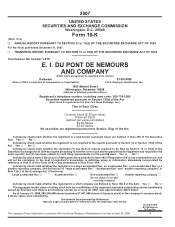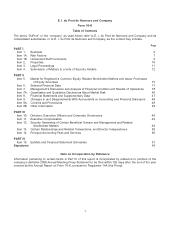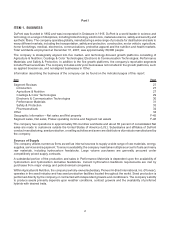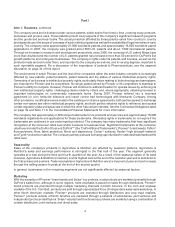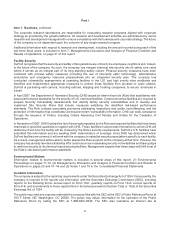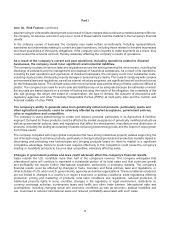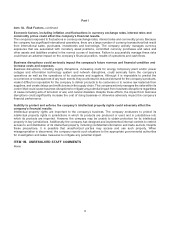DuPont 2007 Annual Report Download - page 9
Download and view the complete annual report
Please find page 9 of the 2007 DuPont annual report below. You can navigate through the pages in the report by either clicking on the pages listed below, or by using the keyword search tool below to find specific information within the annual report.Item 1. Business, continued
http://www.sec.gov that contains reports, proxy and information statements, and other information regarding issuers
that file electronically with the SEC.
The company’s annual report on Form 10-K, quarterly reports on Form 10-Q, current reports on Form 8-K and
amendments to those reports are also accessible on the company’s website at http://www.dupont.com by clicking on
the tab labeled “Investor Center” and then on “SEC filings.” These reports are made available, without charge, as
soon as is reasonably practicable after the company files or furnishes them electronically with the Securities and
Exchange Commission.
ITEM 1A. RISK FACTORS
The company’s operations could be affected by various risks, many of which are beyond its control. Based on current
information, the company believes that the following identifies the most significant risk factors that could affect its
businesses. However, the risks and uncertainties the company faces are not limited to those discussed below.
Additional risks and uncertainties not presently known to the company or that the company currently believes to be
immaterial also could affect its businesses. Past financial performance may not be a reliable indicator of future
performance and historical trends should not be used to anticipate results or trends in future periods.
Price increases for energy and raw materials could have a significant impact on the company’s ability
to sustain and grow earnings.
The company’s manufacturing processes consume significant amounts of energy and raw materials, the costs of
which are subject to worldwide supply and demand as well as other factors beyond the control of the company.
Significant variations in the cost of energy, which primarily reflect market prices for oil and natural gas and raw
materials affect the company’s operating results from period to period. When possible, the company purchases raw
materials through negotiated long-term contracts to minimize the impact of price fluctuations. Additionally, the
company enters into over-the-counter and exchange traded derivative commodity instruments to hedge its exposure
to price fluctuations on certain raw material purchases. The company has taken actions to offset the effects of higher
energy and raw material costs through selling price increases, productivity improvements and cost reduction
programs. Success in offsetting higher raw material costs with price increases is largely influenced by competitive
and economic conditions and could vary significantly depending on the market served. If the company is not able to
fully offset the effects of higher energy and raw material costs, it could have a significant impact on the company’s
financial results.
Failure to develop and market new products could impact the company’s competitive position and
have an adverse effect on the company’s financial results.
The company’s operating results are largely dependent on its ability to renew its pipeline of new products and
services and to bring those products and services to market. This ability could be adversely affected by difficulties or
delays in product development such as the inability to identify viable new products, successfully complete research
and development, obtain relevant regulatory approvals, obtain intellectual property protection, or gain market
acceptance of new products and services. Because of the lengthy development process, technological challenges
and intense competition, there can be no assurance that any of the products the company is currently developing, or
could begin to develop in the future, will achieve substantial commercial success. Sales of the company’s new
products could replace sales of some of its current products, offsetting the benefit of even a successful product
introduction.
The company’s results of operations could be adversely affected by litigation and other commitments
and contingencies.
The company faces risks arising from various unasserted and asserted litigation matters, including, but not limited
to, product liability claims, patent infringement claims and antitrust claims. The company has noted a nationwide
trend in purported class actions against chemical manufacturers generally seeking relief such as medical
monitoring, property damages, off-site remediation and punitive damages arising from alleged environmental
torts without claiming present personal injuries. Various factors or developments can lead to changes in current
estimates of liabilities such as a final adverse judgment, significant settlement or changes in applicable law. A future
7
Part I

